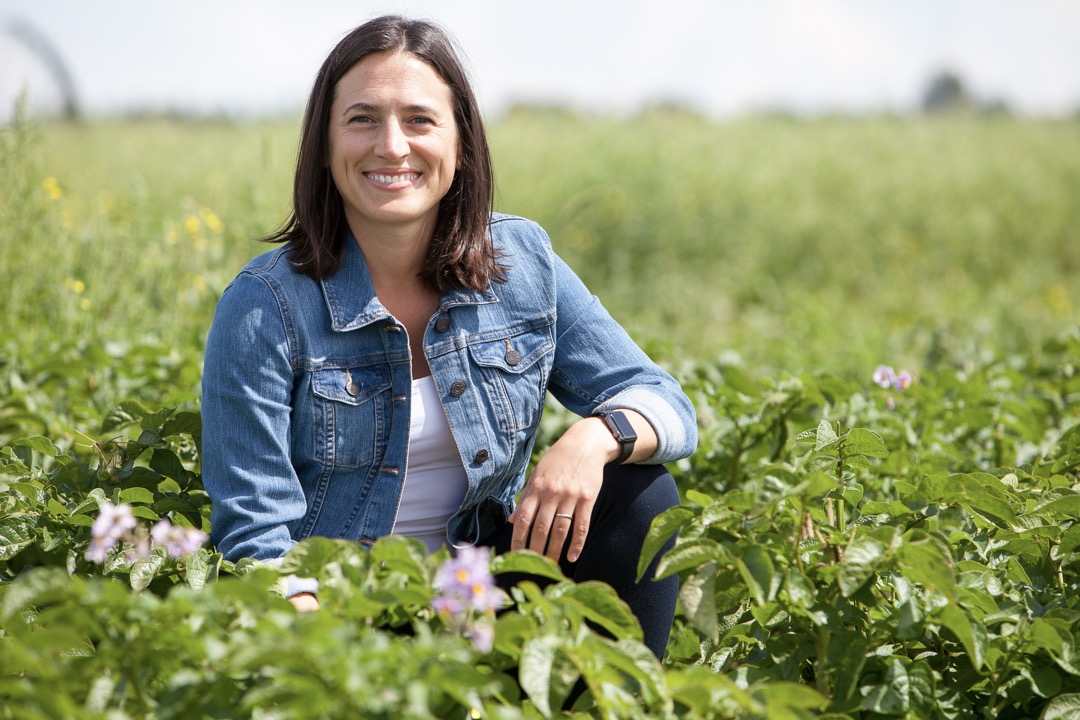
Producing food in sustainable ways
As populations grow, so do demands on farmers to produce more food while somehow preserving the natural systems that sustain agriculture—and everything else.
By Michael Robin“We need to provide sufficient nutritious food to a growing population, but we must do so in a way that is environmentally friendly,” said Dr. Kate Congreves (PhD). “That means optimizing crop production while simultaneously minimizing soil health degradation and nutrient loss to the environment.”
Congreves describes her work as environmental agronomy. An assistant professor in the Department of Plant Sciences in the College of Agriculture and Bioresources at the University of Saskatchewan (USask), her research group is devoted to studying farming practices that can meet producer goals while reducing environmental impacts. In doing so, she focuses on two elements—nitrogen and carbon. Her work encompasses horticultural crops as well as field crops.
Congreves explains that a healthy soil is one that functions in three ways: to sustain biological productivity, to support environmental quality, and to sustain the health of plants and animals—including humans. The soil’s capacity to function determines the extent to which it can provide ecosystem services, either on its own or indirectly through plants.
“Ecosystem services are what support life on Earth,” said Congreves, listing examples including biomass production (food, fuel, fibre), greenhouse gas sequestration, provisioning of nutrients, and preserving water quality.
“All things wouldn’t be able to live without these services.”
“Improving the efficiency of the monocultural practices has been a key focus of production,” Congreves said. “But we can still learn from nature, and from older or alternative practices such as intercropping or cover cropping, thereby realizing the ecological benefits that arise from diversification.”
For example, one of her research projects is looking at intercropping, a practice famously used by Indigenous peoples in North America with corn, squash and beans. Her project uses a “service crop” or “undercrop,” in this case red clover, seeded together with a main crop such as wheat. Bacteria housed in the clover’s roots fix nitrogen from the air to fertilize both the clover and the wheat. She has other projects exploring the use of cover crops in vegetable crop rotations, for example, broccoli—sweet corn—root crops.
Many of the concepts Congreves speaks of would be well known to those familiar with organic production or in regenerative agriculture. Environmental agronomy is a broader term that encompasses all production systems.
“It is not a matter of organic versus conventional production; I don’t think there’s a line drawn in the sand,” she said. “It’s a blend between the two ideologies that will take us forward. It’s being mindful of managing the soil as well as managing the crop.”
An example of this is minimum and no-till seeding and leaving crop residues on the field, which have become standard practices that help build healthy soils, retain moisture, and prevent erosion.
Congreves explained there are two components at play. One, of course, is to produce healthy food. The other is to maximize carbon inputs and minimize losses. Carbon-rich soils have better structure for plant growth, promoting aeration and water retention. They also store carbon that would otherwise end up in the atmosphere as carbon dioxide, a greenhouse gas that contributes to climate change.
“In doing both, you’re getting closer towards regenerative agriculture—whether you do it conventionally or organically,” she said.
Managing nutrients is also an important part of Congreves’ work. She is currently looking at nitrogen use efficacy in potato production and also in spring wheat. Identifying how different management and varieties affect nitrogen use efficiency can help inform how best to produce food in a way that capitalizes on nutrient cycling and minimizes the amount of nitrogen lost to the environment.
On the greenhouse gas side of things, she is involved in setting up a micrometeorological station in Saskatoon that measures greenhouse gas fluxes from cropping systems, year-round. This will help provide the carbon footprint data needed to better understand carbon and nitrous oxide dynamics in cropping systems.
Mitigating the environmental impact of farming while maintaining and increasing food production is a global challenge. By the end of this year, there will be 82 million more mouths to feed on a planet already home to more than 7.8 billion. By mid-century, this is expected to top 9.7 billion. Humanity cultivates more than 4.6 billion acres, an area nearly twice the size of Canada.
Congreves’ fascination for soil and the plants that grow in it began on her parents’ 100-acre hobby farm outside of Ottawa. There, she and her siblings would take their toy trucks and build elaborate networks of roads through the family’s extensive garden, circling around the plant roots. Their mini roadworks extended right out to the lush vines and leaves of the pumpkin patch, thriving in the carbon-rich compost pile.
“I would do lots of home gardening even as a child,” she said. “We grew such a diversity of vegetables each year.
“I think that's what got me into it (soil and plant science), because we were always outside, just being close to nature.”
Congreves did her undergraduate studies in biology and chemistry at Queen’s University in Kingston and went on to earn her PhD in land resource science at the University of Guelph’s Ridgetown campus. There, she worked on nitrogen cycling in vegetable crops, soil health, and long-term crop rotations. She joined USask in early 2017.
Agknowledge, December 2020

